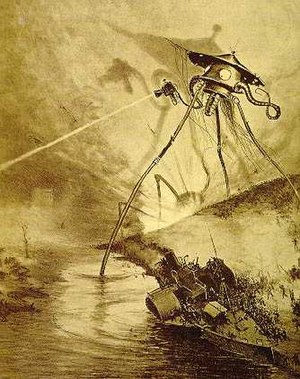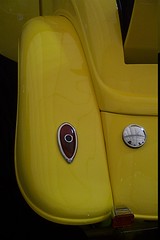 Image via Wikipedia
Image via Wikipedia
I was surprised at how much I'd forgotten. In particular I had no memory of the black smoke the martians used to clear towns and cities nor of the red weed that they used to choke the landscape. That was good to know because I want to make the destruction they wrought far more widespread. I think I can stretch things enough to make that work. Plus there's nothing to say that the Martians didn't come back. Chances are that, if they did, they'd be much better prepared. Or just really annoyed.
Can life survive without the microbes that the Martians lack? They do good things for us humans. In fact, I'm pretty sure that all life got started via the medium of such things. I guess Wells didn't know about that though. The classic Miller-Urey experiment on primordial soup wasn't done until 1953 and a lot of subsequent work has been done on the evolution of unicellular and multi-cellular organisms. The shift from uni (prokaryotes) to multi (eukaryotes) is a pretty pivotal moment in the history of life on Earth. Here's a thought - a good one for a story. What if in travelling to Mars we find no evidence of them evolving there. So they came from somewhere else.
Re-reading the book, which took about 3.5 commutes, also made me realise how faithful the Spielberg movie was. I was expecting that to be a story of plucky-humans-beating-the-martians-by-dint-of-their-unquenchable-spirit with Tom in the role of hero. But it was pretty bleak and Tom Cruise's character was not very likeable. I suspect part of the reason for the reviews saying it was mediocre were because it didn't submit to that Hollywood idealisation of struggle against the alien oppressors. Ooh, hark at him.
What struck me when I was looking into WotW was how many people have used it as a starting point for more stories. Lots of anthologies have been produced taking the invasion as their starting point. What is also interesting is what they did not consider. Well, almost all of them. Superstition forbids me from saying more.
![Reblog this post [with Zemanta]](http://img.zemanta.com/reblog_e.png?x-id=54eb694b-eabd-4590-b736-179424c55798)




![Reblog this post [with Zemanta]](http://img.zemanta.com/reblog_e.png?x-id=05b7622f-1dc4-4124-b712-355b14bbcb2b)
